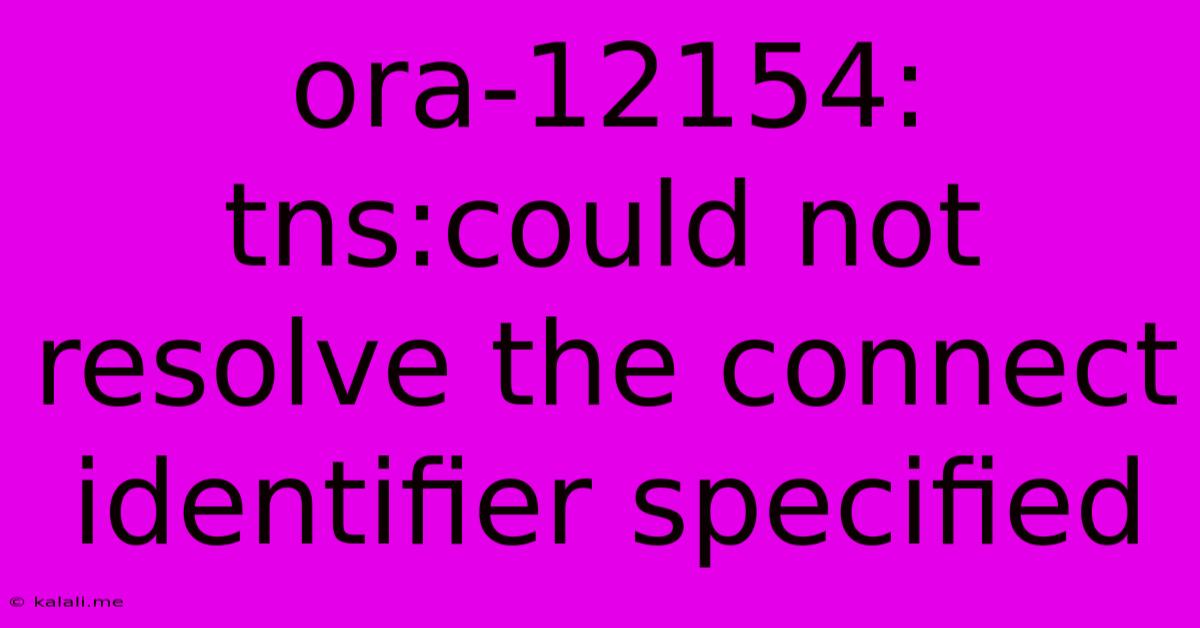Ora-12154: Tns:could Not Resolve The Connect Identifier Specified
Kalali
May 22, 2025 · 4 min read

Table of Contents
ORA-12154: TNS: Could Not Resolve the Connect Identifier Specified – Troubleshooting Guide
Meta Description: Encountering the dreaded ORA-12154 error? This comprehensive guide explains the causes of this Oracle error, "TNS:could not resolve the connect identifier specified," and provides effective troubleshooting steps for quick resolution. Learn how to check your TNS configuration, network connectivity, and Oracle listener status to get your database connection working again.
The ORA-12154 error, "TNS:could not resolve the connect identifier specified," is a common headache for anyone working with Oracle databases. This error signifies that your Oracle client cannot locate the database instance you're trying to connect to. This seemingly simple issue can stem from various underlying problems, ranging from simple typos in your connection string to more complex network or configuration issues. This guide provides a structured approach to troubleshooting this error, leading you to a swift resolution.
Understanding the Error
The error message itself is quite explicit: the client application (e.g., SQL*Plus, your application code) cannot find the database using the connection identifier (also known as the connect string) you've provided. This identifier usually includes the database service name, hostname, and port number. The failure to resolve this identifier means there's a disconnect between your client and the database server.
Common Causes of ORA-12154
Several factors can contribute to the ORA-12154 error. Let's examine the most prevalent ones:
-
Incorrect TNS Configuration: The most frequent cause is an issue with your Oracle Net configuration files (usually
tnsnames.ora). Typos in the service name, hostname, port number, or SID are common culprits. Incorrect paths to the configuration files can also lead to this error. -
Network Connectivity Problems: This error can also occur due to network connectivity issues. The client might be unable to reach the database server due to firewall restrictions, incorrect network settings, or a failure in network infrastructure.
-
Oracle Listener Issues: The Oracle listener is a crucial component that acts as a gateway between client applications and the database. If the listener is down or not configured correctly, you'll encounter this error.
-
Incorrect Hostname or Service Name: A simple mistake in specifying the hostname or service name in your connect string can prevent the connection. Double-check these values against your database server configuration.
-
Firewall Interference: Firewalls can sometimes block connections to the database port (typically 1521, but configurable). Ensure that the firewall allows traffic on the designated port.
Troubleshooting Steps
Follow these steps to diagnose and resolve the ORA-12154 error:
1. Verify TNS Configuration:
-
Locate
tnsnames.ora: Find thetnsnames.orafile. The location varies depending on your operating system and Oracle client installation. Common locations include the$ORACLE_HOME/network/admindirectory or your user's profile directory. -
Check Service Name: Ensure the service name in your
tnsnames.orafile matches the service name defined on the database server. -
Verify Hostname and Port: Double-check the hostname (or IP address) and port number. The default port is usually 1521.
-
Check for Typos: Carefully review the entire
tnsnames.oraentry for any typos or syntax errors.
2. Test Network Connectivity:
-
Ping the Database Server: Use the
pingcommand to verify network connectivity to the database server's hostname or IP address. A successful ping suggests network connectivity is established. -
Telnet to the Database Port: Use
telnet(or a similar tool) to test connectivity to the database port. For example,telnet <database_hostname> 1521. A successful connection indicates the port is open and accessible.
3. Check Oracle Listener Status:
-
Check Listener Status: Use the
lsnrctl statuscommand (from the$ORACLE_HOME/bindirectory) to check the status of the Oracle listener. The listener should be running. -
Restart Listener (if necessary): If the listener is not running, start it using
lsnrctl start.
4. Verify Database Status:
- Connect as SYSDBA (if possible): Try connecting to the database as the SYSDBA user to rule out any user-specific connection issues. This requires appropriate privileges.
5. Review Firewall Rules:
- Check Firewall Settings: Ensure that your firewall allows incoming connections on the database port (usually 1521).
6. Check for DNS Resolution Issues:
If you're using a hostname, make sure your system can correctly resolve it to an IP address using nslookup <database_hostname>.
By methodically following these troubleshooting steps, you should be able to identify the root cause of the ORA-12154 error and restore your connection to the Oracle database. Remember to always consult the Oracle documentation for the most up-to-date and detailed information.
Latest Posts
Latest Posts
-
Why Is Ginger Beer Called Ginger Beer
May 22, 2025
-
How To Stop Squeaky Windows On Car
May 22, 2025
-
How To Move A Washing Machine By Yourself
May 22, 2025
-
Calculate The Area Of The Shaded Section Of This Shape
May 22, 2025
-
Who Can Access My Bank Account Without My Permission
May 22, 2025
Related Post
Thank you for visiting our website which covers about Ora-12154: Tns:could Not Resolve The Connect Identifier Specified . We hope the information provided has been useful to you. Feel free to contact us if you have any questions or need further assistance. See you next time and don't miss to bookmark.